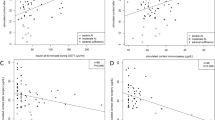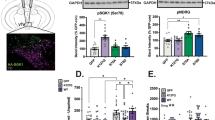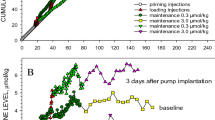Abstract
The loss of control over cocaine use and persistently heightened susceptibility to drug relapse that define human cocaine addiction are consequences of drug-induced neuroplasticity and can be studied in rats self-administering cocaine under conditions of daily long access (LgA) as escalating patterns of drug intake and heightened susceptibility to reinstatement. This study investigated the potential contribution of elevated glucocorticoids at the time of LgA cocaine self-administration (SA) to these behavioral indices of addiction-related neuroplasticity. Rats provided 14 days of 6-h access (LgA) to cocaine showed a progressive escalation of SA and were more susceptible to cocaine-induced reinstatement (10 mg/kg, i.p.) compared to rats self-administering under short-access (ShA; 2 h) conditions. A surgical adrenalectomy and corticosterone replacement (ADX/C) regimen that eliminated SA-induced increases in corticosterone (CORT) while maintaining the diurnal pattern of secretion failed to alter SA or reinstatement in ShA rats but slowed escalation and attenuated later reinstatement in LgA rats when applied before but not after chronic LgA SA testing. Although the contribution of other adrenal hormones cannot be ruled out, these data suggest that elevated glucocorticoids at the time of cocaine exposure may be required for the effects of LgA SA on cocaine intake and later reinstatement. The inability of daily CORT administration before daily ShA SA, at a dose that reproduced the response during LgA SA, to mimic the effects of LgA SA suggests that elevated glucocorticoids during SA may play a permissive role in cocaine-induced neuroplasticity that contributes to addiction.
Similar content being viewed by others
Log in or create a free account to read this content
Gain free access to this article, as well as selected content from this journal and more on nature.com
or
References
Ahima RS, Harlan RE (1990). Charting of type II glucocorticoid receptor-like immunoreactivity in the rat central nervous system. Neuroscience 39: 579–604.
Ahmed SH, Cador M (2006). Dissociation of psychomotor sensitization from compulsive cocaine consumption. Neuropsychopharmacology 31: 563–571.
Ahmed SH, Koob GF (1999). Long-lasting increase in the set point for cocaine self-administration after escalation in rats. Psychopharmacology 146: 303–312.
Ahmed SH, Koob GF (1998). Transition from moderate to excessive drug intake: change in hedonic set point. Science 282: 298–300.
Ahmed SH, Koob GF (2004). Changes in response to a dopamine receptor antagonist in rats with escalating cocaine intake. Psychopharmacology 172: 450–454.
Ahmed SH, Lin D, Koob GF, Parsons LH (2003). Escalation of cocaine self-administration does not depend on altered cocaine-induced nucleus accumbens dopamine levels. J Neurochem 86: 102–113.
Baker DA, Tran-Nguyen LT, Fuchs RA, Neisewander JL (2001). Influence of individual differences and chronic fluoxetine treatment on cocaine-seeking behavior in rats. Psychopharmacology 155: 18–26.
Barrot M, Marinelli M, Abrous DN, Rouge-Pont F, Le Moal M, Piazza PV (2000). The dopaminergic hyper-responsiveness of the shell of the nucleus accumbens is hormone-dependent. Eur J Neurosci 12: 973–979.
Ben-Shahar O, Moscarello JM, Ettenberg A (2006). One hour, but not six hours, of daily access to self-administered cocaine results in elevated levels of the dopamine transporter. Brain Res 1095: 148–153.
Borrell J, de Kloet ER, Verteeg DH, Bohus B (1983). Inhibitory avoidance deficit following short-term adrenalectomy in the rat: the role of adrenal catecholamines. Behav Neural Biol 39: 241–258.
Broadbear JH, Winger G, Woods JH (1999). Cocaine-reinforced responding in rhesus monkeys: pharmacological attenuation of the hypothalamic-pituitary-adrenal response. J Pharmacol Exp Ther 290: 1347–1355.
Campbell UC, Carroll ME (2001). Effects of ketoconazole on the acquisition of intravenous cocaine self-administration under different feeding conditions in rats. Psychopharmacology 154: 311–318.
Corpechot C, Robel P, Axelson M, Sjovall J, Baulieu EE (1981). Characterization and measurement of dehydroepiandrosterone sulfate in rat brain. Proc Natl Acad Sci USA 78: 4704–4707.
de Kloet ER, Joels M, Holsboer F (2005). Stress and the brain: from adaptation to disease. Nat Rev Neurosci 6: 463–475.
Deroche V, Marinelli M, Le Moal M, Piazza PV (1997). Glucocorticoids and behavioral effects of psychostimulants. II. Cocaine intravenous self-administration and reinstatement depend on glucocorticoid levels. J Pharmacol Exp Ther 281: 1401–1407.
Doron R, Fridman L, Gispan-Herman I, Maayan R, Weizman A, Yadid G (2006). DHEA, a neurosteroid, decreases cocaine self-administration and reinstatement of cocaine-seeking behavior in rat. Neuropsychopharmacology 31: 2231–2236.
Erb S, Shaham Y, Stewart J (1998). The role of corticotrophin-releasing factor and corticosterone in stress- and cocaine-induced relapse to cocaine seeking in rats. J Neurosci 18: 5529–5536.
Ferrario CR, Gorny G, Crombag HS, Li Y, Kolb B, Robinson TE (2005). Neural and behavioral plasticity associated with the transition from controlled to escalated cocaine use. Biol Psychiatry 58: 751–759.
Galici R, Pechnick RN, Poland RE, France CP (2000). Comparison of noncontingent versus contingent cocaine administration on plasma corticosterone levels in rats. Eur J Pharmacol 387: 59–62.
Ghitza UE, Rothman RB, Gorelick DA, Henningfield JE, Baumann MH (2007). Serotonergic responsiveness in human cocaine users. Drug Alcohol Depend 86: 207–213.
Goeders NE, Guerin GF (1996a). Role of corticosterone in intravenous cocaine self-administration. Neuroendocrinology 64: 337–348.
Goeders NE, Guerin GF (1996b). Effects of surgical and pharmacological adrenalectomy on the initiation and maintenance of intravenous cocaine self-administration in rats. Brain Res 25: 145–152.
Harfstrand A, Fuxe K, Cintra A, Agnati LF, Zini I, Wikstrom AC et al (1986). Glucocorticoid receptor immunoreactivity in monoaminergic neurons of rat brain. Proc Natl Acad Sci USA 83: 9779–9783.
Jacobson L, Akana SF, Cascio CS, Shinsako J, Dallman MF (1988). Circadian variations in plasma corticosterone permit normal termination of the adrenocorticotropin responses to stress. Endocrinology 122: 1343–1348.
Joels M, de Kloet ER (1994). Mineralocorticoid and glucocorticoid receptors in the brain: implications for ion permeability and transmitter systems. Prog Neurobiol 43: 1–36.
Kippin TE, Fuchs RA, See RE (2006). Contributions of prolonged contingent and noncontingent cocaine exposure to enhanced reinstatement of cocaine seeking in rats. Psychopharmacology 187: 60–67.
Kosten TR, Oliveto A, Sevarino KA, Gonsai K, Feingold A (2002). Ketoconazole increases cocaine and opioid use in methadone maintained patients. Drug Alcohol Depend 66: 173–180.
Lee B, Tiefenbacher S, Platt DM, Spealman RD (2003). Role of the hypothalamic-pituitary-adrenal axis in reinstatement of cocaine-seeking behavior in squirrel monkeys. Psychopharmacology 168: 177–183.
Mantsch JR, Goeders NE (1999). Ketoconazole does not block cocaine discrimination or the cocaine-induced reinstatement of cocaine-seeking behavior. Pharmacol Biochem Behav 64: 65–73.
Mantsch JR, Katz ES (2007). Elevation of glucocorticoids is necessary but not sufficient for the escalation of cocaine self-administration by chronic electric footshock stress in rats. Neuropsychopharmacology 32: 367–376.
Mantsch JR, Saphier D, Goeders NE (1998). Corticosterone facilitates the acquisition of cocaine self-administration in rats: opposite effects of the type II receptor agonist dexamethasone. J Pharmacol Exp Ther 287: 72–80.
Mantsch JR, Yuferov V, Mathieu-Kia A-M, Ho A, Kreek MJ (2003). Neuroendocrine alterations in a high-dose, extended-access rat self-administration model of escalating cocaine use. Psychoneuroendocrinology 28: 836–862.
Mantsch JR, Yuferov V, Mathieu-Kia A-M, Ho A, Kreek MJ (2004). Effects of extended access to high versus low cocaine doses on self-administration, cocaine-induced reinstatement and brain mRNA levels in rats. Psychopharmacology 175: 26–36.
Marinelli M, Piazza PV, Deroche V, Maccari S, Le Moal M, Simon H (1994). Corticosterone circadian secretion differentially facilitates dopamine-mediated psychomotor effect of cocaine and morphine. J Neurosci 14: 2724–2731.
Mateo Y, Lack CM, Morgan D, Roberts DC, Jones SR (2005). Reduced dopamine terminal function and insensitivity to cocaine following cocaine binge self-administration and deprivation. Neuropsychopharmacology 30: 1455–1463.
McCracken CB, Hamby SM, Patel KM, Morgan D, Vrana KE, Roberts DC (2005). Extended cocaine self-administration and deprivation produces region-specific and time-dependent changes in connexin36 expression in rat brain. Synapse 58: 141–150.
McEwen BS (2005). Glucocorticoids, depression, and mood disorders: structural remodeling in the brain. Metabolism 54: 20–23.
Meyer JS, Micco DJ, Stephenson BS, Krey LC, McEwen BS (1979). Subcutaneous implantation method for chronic glucocorticoid replacement therapy. Physiol Behav 22: 867–870.
Peskind ER, Raskind MA, Wilkinson CW, Flatness DE, Halter JB (1986). Peripheral sympathectomy and adrenal medullectomy do not alter cerebrospinal fluid norepinephrine. Brain Res 367: 258–264.
Piazza PV, Rouge-Pont F, Deroche V, Maccari S, Simon H, Le Moal M (1996). Glucocorticoids have state-dependent stimulant effects on the mesencephalic dopaminergic neurotransmission. Proc Natl Acad Sci USA 93: 8716–8720.
Prasad BM, Ulibarri C, Sorg BA (1998). Stress-induced cross-sensitization to cocaine: effect of adrenalectomy and corticosterone after short- and long-term withdrawal. Psychopharmacology 136: 24–33.
Rouge-Pont F, Marinelli M, Le Moal M, Simon H, Piazza PV (1995). Stress-induced sensitization and glucocorticoids. II. Sensitization of the increase in extracellular dopamine induced by cocaine depends on stress-induced corticosterone secretion. J Neurosci 15: 7189–7195.
Saal D, Dong Y, Bonci A, Malenka RC (2003). Drugs of abuse and stress trigger a common synaptic adaptation in dopamine neurons. Neuron 37: 577–582.
Sapolsky RM, Romero M, Munck AU (2000). How do glucocorticoids influence stress responses? Integrating permissive, suppressive, stimulatory, and preparative actions. Endocrine Rev 21: 55–89.
Sutton MA, Karanian DA, Self DW (2000). Factors that determine a propensity for cocaine-seeking behavior during abstinence in rats. Neuropsychopharmacology 22: 626–641.
Van Craenenbroeck K, De Bosscher K, Vanden Berghe W, Vanhoenacker P, Haegeman G (2005). Role of glucocorticoids in dopamine-related neuropsychiatric disorders. Mol Cell Endocrinol 245: 10–22.
Ward AS, Collins ED, Haney M, Foltin RW, Fischman MW (1999). Blockade of cocaine-induced increases in adrenocorticotrophic hormone and cortisol does not attenuate the subjective effects of smoked cocaine in humans. Behav Pharmacol 10: 523–529.
Weinshenker D, Schroeder JP (2006). There and back again: a tale of norepinephrine and drug addiction. Neuropsychopharmacology [E-pub ahead of print; doi:10.1038/sj.npp.1301263].
Yang YL, Chao PK, Lu KT (2006). Systemic and intra-amygdala administration of glucocorticoid agonist and antagonist modulate extinction of conditioned fear. Neuropsychopharmacology 31: 912–924.
Acknowledgements
This work was supported by National Institute on Drug Abuse (NIDA) grants number DA15758 to JRM and DA017328 to DAB. We thank Tanveer Sajan for her technical assistance and Dr Kristen Kau for her helpful comments on the manuscript.
Author information
Authors and Affiliations
Corresponding author
Additional information
DISCLOSURE/CONFLICT OF INTEREST
Conflicts:
The authors declare that they have no conflict of interest related to this report.
Professional affiliations:
John R Mantsch and David A Baker are affiliated with Promentis Pharmaceuticals.
Joseph P Serge, Michael A Hoks, David M Francis, and Eric S Katz have no other professional affiliation at this time.
Rights and permissions
About this article
Cite this article
Mantsch, J., Baker, D., Serge, J. et al. Surgical Adrenalectomy with Diurnal Corticosterone Replacement Slows Escalation and Prevents the Augmentation of Cocaine-Induced Reinstatement in Rats Self-Administering Cocaine Under Long-Access Conditions. Neuropsychopharmacol 33, 814–826 (2008). https://doi.org/10.1038/sj.npp.1301464
Received:
Revised:
Accepted:
Published:
Issue date:
DOI: https://doi.org/10.1038/sj.npp.1301464
Keywords
This article is cited by
-
Role of mesolimbic cannabinoid receptor 1 in stress-driven increases in cocaine self-administration in male rats
Neuropsychopharmacology (2023)
-
Improving translation of animal models of addiction and relapse by reverse translation
Nature Reviews Neuroscience (2020)
-
CB1 receptor antagonism blocks stress-potentiated reinstatement of cocaine seeking in rats
Psychopharmacology (2016)
-
Adrenal Activity during Repeated Long-Access Cocaine Self-Administration is Required for Later CRF-Induced and CRF-Dependent Stressor-Induced Reinstatement in Rats
Neuropsychopharmacology (2011)
-
Two modes of intense cocaine bingeing: increased persistence after social defeat stress and increased rate of intake due to extended access conditions in rats
Psychopharmacology (2009)



